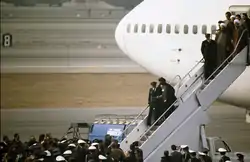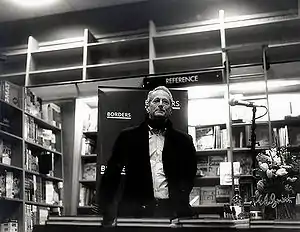David Burnett (photojournalist)
David Burnett (born 1946)[1] is an American magazine photojournalist based in Washington, D.C. His work from the 1979 Iranian revolution was published extensively in Time (including its "Man of the Year" portrait of the Ayatollah Khomeini).
.jpg.webp)


He has won dozens of top awards for his work, including the 1973 Robert Capa Gold Medal (with Raymond Depardon and Chas Gerretsen) from the Overseas Press Club for work in Chile,[2] Magazine Photographer of the Year from the National Press Photographers Association, and World Press Photo of the Year.[3]
He was a member of the Gamma photo agency and co-founded Contact Press Images.
| External images | |
|---|---|
Life and work
Burnett was born in 1946 in Salt Lake City, Utah. He graduated from Colorado College in 1968 and began working as a freelance photographer for Time and Life, first in the United States and later in Vietnam. On June 8, 1972. Burnett was one of the photojournalists present at Trảng Bàng in Tây Ninh Province when Nick Ut of the Associated Press captured his famous image of the nine-year-old Vietnamese girl Phan Thị Kim Phúc and some other children fleeing a napalm attack. Two South Vietnamese Skyraider aircraft went off course and dropped the incendiary bombs near the journalists, resulting in the deaths of two children and inflicting serious burns on others, including Kim Phúc. Burnett also shot pictures of the scene.[4] After two years in Vietnam, he joined the French photo agency Gamma, travelling the world for its news department for two years.
In 1975 he co-founded a new photo agency, Contact Press Images, in New York City. For the last three decades he has traveled extensively, working for most of the major magazines in the United States and Europe. His work covering the 2004 Olympics with an array of antiquated cameras and films received positive reviews in the photography press and in The New York Times.
In 2004, Burnett also used his Speed Graphic with a 178mm f/2.5 Aero-Ektar lens removed from a K-24 aerial camera to cover the Presidential campaign of John Kerry.[5]
In 2009 Burnett published a book of intimate, unpublished images he took of reggae singer Bob Marley, titled Soul Rebel. In 2019, the fiftieth anniversary of the launch of Apollo 11, the first manned mission to the Moon, he published We Choose to Go to the Moon, a book of photos taken around the launch pad in Cape Canaveral.
References
- http://www.contactpressimages.com/44Days/bio.html
- "The Robert Capa Gold Medal 1973 Archived 2012-09-05 at Archive.today", Overseas Press Club of America. Accessed 2010-07-13.
- World Press Photo
- Chong, Denise (1999). The Girl in the Picture: The Kim Phúc Story. Viking. p. 56. ISBN 0-670-88040-X.
- Seth Schiesel, "Which Camera Does This Pro Use? It Depends on the Shot". New York Times, 8 June 2005. Frank Van Riper, "Burnett's 4x5: Covering Politics the Hard Way", "Camera Works", Washington Post, n.d. (1994). Both accessed 2010-02-16.